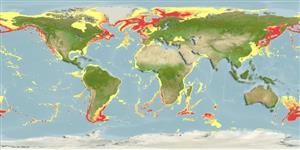Common names from other countries
Classification / Names / Names
Common names | Synonyms | Catalog of Fishes (gen., sp.) | ITIS | CoL | WoRMS
Environment: milieu / climate zone / depth range / distribution range
Ecology
Sessile; depth range 5 - 2440 m (Ref. 120471). Subtropical
Arctic, Atlantic and Pacific Oceans. Mostly polar, but also in subtropical, temperate and boreal climates.
Length at first maturity / Size / Weight / Age
Maturity: Lm ? range ? - ? cm
Colonial (Refs. 19, 87872). This is an attached species (Ref. 3123). Found at depths of 5 to 2440 m (Ref. 120471). The feeding type of this species is suspension feeding (Ref. 87872).
Life cycle and mating behavior
Maturity | Reproduction | Spawning | Eggs | Fecundity | Larvae
Species exhibits both asexual and sexual reproduction by budding during hydroid stage and release of gametes in medusae stages (Ref. 1663, p. 24).
Cairns, S.D., D.R. Calder, A. Brinckmann-Voss, C.B. Castro, D.G. Fautin, P.R. Pugh, C.E. Mills, W.C. Jaap, M.N. Arai, S.H.D. Haddock and D.M. Opresko. 2003. (Ref. 1663)
IUCN Red List Status (Ref. 130435)
CITES status (Ref. 108899)
Not Evaluated
Not Evaluated
Human uses
| FishSource |
Tools
More information
Age/Size
Growth
Length-weight
Length-length
Morphology
Larvae
Abundance
Internet sources
Estimates based on models
Preferred temperature
(Ref.
115969): 1 - 11.1, mean 5.8 (based on 1656 cells).
Price category
Unknown.
